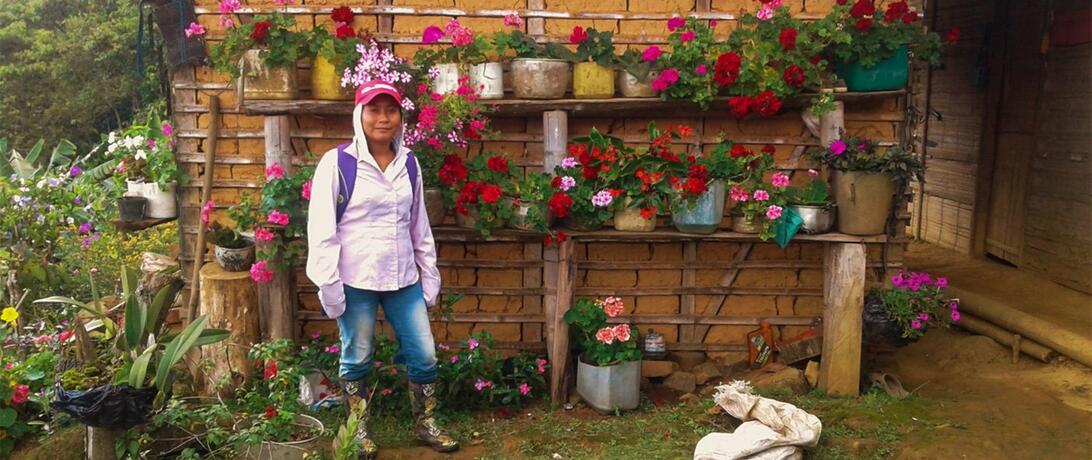
Mario Espinoza of One Earth Future program, Shared Resources, paints an image of the powerful traditions and peace activism of the Nasa women of Colombia.
This is the sixth installment in a blog series on civil society engagement with the Women, Peace and Security agenda. The series shares perspectives from multiple focus areas of One Earth Future. Contributors to the series include Alexandra Amling, Kelsey Coolidge, and Catie Fowler. Catch up on your reading for this series with the first four blogs on civil society organizations, the peace process in South Sudan, funding barriers to Women, Peace and Security, and National Action Plans in the Middle East and North Africa and the Pacific Region.
This piece by Mario Espinosa of One Earth Future’s Shared Resources program with framing from Alex Amling of OEF Research provides insight into the traditions and culture of the Nasa indigenous people of Colombia, a tribe known for their activism for peace, good governance, and respect for the earth.
A critical component of Women, Peace and Security, women’s participation in peacemaking and peacebuilding can take different forms. In an ethnically and racially diverse country like Colombia, notions of peace and security are shaped by history, but more importantly by deep-rooted cultural attitudes and behaviors.
As Colombia transitions from five decades of violent armed conflict to peace, Colombia’s indigenous Nasa women, “U’ma” in the Nasa language, employ ancestral knowledge and practices to reweave the fabric of society. During an Andean evening under the tutelary shadow of the Munchique sacred mountain in the Cauca Department of Colombia, the U’ma can be seen weaving the chumbe, a traditional Nasa belt. Using nature-inspired designs which represent their cosmovision, the weaving is as much an exercise as it is a narration of an intimate philosophy in which the women create a spiritual bond with kiwethengu (the protector of Mother Nature).
The chumbe belt exemplifies how Nasa women are the weavers and creators of life, an extension of a woman’s womb to her child on her back. This unifying symbol of the chumbe underscores the outstanding role Nasa women have played in the community’s struggle for territorial revindication and the recognition of their land and rights. They have internalized the principles of the Nasa movement: culture, unity, autonomy, and survival within their territory.
The “Law of Origin,” the shared history and practice of the Nasa, has provided the women with the necessary attributes to harmonize communal life around the principles of tolerance, equity, and affection. The Nasa’s resistance to armed violence is fueled by their identity as a community that is based on spiritual, normative, and collective concepts, which has provided them with strength in times of war.
Following in the footsteps of their elders, Nasa women strive to live with dignity, justice, and peace. As a result, they participate in many essential processes of resistance, and their activism has political and economic impacts on the community. For example, Nasa women have assumed leading roles in the Cabildos (indigenous government), in representative spaces, and in projects of a social and cultural nature, such as the Nasa-Kiwes (Indigenous Guards). According to the women, "Without women, there is no government of their own, there is no autonomy, or unity. We are part of the process, and without us, the process does not exist."
The leadership of the Nasa women is consistent with proven truths about the leadership of women globally. Women in a variety of countries and cultures exhibit an aptitude for building peace coalitions and creating dialogue and compromise among parties to conflict. They frequently press for the consideration of political, economic, and social issues that are critical to sustainable peace and democracy. The activism of the Nasa women in Colombia is yet another example of how the leadership of women can be used to promote peace.
Understanding the importance of women in the Nasa community, Shared Resources has been promoting women’s inclusion and active participation in project activities in Canoas. Women help coordinate community engagement, are part of decision-making processes, and take leadership roles in all training sessions given to the Mining Governance Council. This is a concrete example of what we know from the research on Women, Peace and Security in other conflict zones: women have the in-depth knowledge of community needs that is critical to successful humanitarian assistance, peace operations, and sustainable peace agreements.
The women have worked continuously, and thanks to their support, dialogues have propitiated the understanding and peaceful transformation of these problems. Understanding that conflict does not simply end with an end to armed violence, Shared Resources works with women because of their cultural notions of peace and security. In their own words, Nasa women are part and parcel of maintaining the umbilical cord from the people to Mother Earth, where the community reestablishes relationships of reciprocity and balance.
Article Details
Published
Topic
Program
Content Type
Opinion & Insights